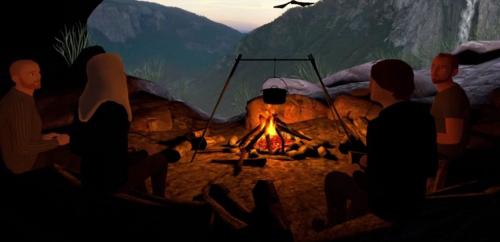“Imagine being able to sit in front of a campfire and hang out with friends anytime you want. Or being able to watch a movie in a private theatre with your friends anytime you want.” That’s what Mark Zuckerberg posed in front of the Mobile World Congress last month as he discussed the future of Facebook and his plans to delve into virtual reality. Well, as it turns out, you can do all of that now, and you don’t necessarily need to go through costly hoops and high-end equipment to experience it.
Mobile VR is making headway worldwide and game developers have been hard at work as they’ve taken the online social experience to the three dimensional level. One of these groups is Starship, a UK-based technology and innovation company that specializes in platforms and content-creation. Early last year, the group identified virtual reality as a significant venture to explore for mobile users. With the cost of entry being much lower on the mobile platform, and with the masses depending on and craving social connections online and in person, Starship saw a place for virtual reality for the mainstream population, a.k.a, those who aren’t necessarily the big gamers.
By the end of 2015 Starship had launched vTime on Samsung phones–a virtual reality social network where all people have to do is don the VR headset, and have their phones and the app handy to get their avatar to meet up with and travel to exotic places with friends, spend quality time with loved ones who live far away, or share photos in real time. Since then, it’s been used by tens of thousands of people worldwide. “vTime is the world’s first social network in VR,” said Julian Price, Chief Marketing Officer at Starship. The difference, he explained, between VTime and the social networks in the 2D world is that the latter is actually quite “unsocial”. “They [2D social networks] are asynchronous. You post information and photos and your friends read it later. In vTime, it’s all in real time.”
vTime will also be completely platform agnostic. Once the hardware reaches the market, the product will be available on Android iOS, PlayStation VR, Oculus Rift, and possibly interactive TV. Price likens the VR adoption by the mainstream population to how the gaming industry has been taken up by average users. While there are the high-end gamers who “sit forward,” meaning they lean in and become completely engaged with a game on their PC, there are also the mobile users who “sit backward” and dip in and out of a game after five minutes on the train. That will be the case in VR too. Some will opt for a totally immersive and high-end experience on the Oculus Rift headset, but the vast majority will be casual users in VR. The difference is that people using a high-end kit will have a more graphic and visually intensive experience than the people using a lower-end kit. While the higher-end equipment use positional tracking and allow users to move around backwards and forwards, mobile platforms typically only use head tracking, meaning a user can move his or her head but cannot move backwards and forwards.
Virtual reality developers are also keen on the first VR experience being a pleasant one for users. Since it’s estimated that 20-30 percent of people feel like they’ve just ridden a roller coaster after a VR experience, Price said a vTime user starts from a sitting position. It’s important not to have people moving around right away, he said.
Price also sees VR as a gateway for the public into augmented reality, which is a mixed reality between the real world and VR. “VR is when you want to go somewhere. AR is when you want to bring ‘somewhere’ to you,” he explained.
But the technology for AR isn’t quite where VR is right now. One can definitely grasp the parallels between VR in its infancy and AR in the future. VR was promoted in the ’90s as the next big thing, though back then it made any one who tried it nauseous and sick. It’s only in recent years that the technology has caught up so that users can have enjoyable experiences at affordable prices. If history repeats itself, we’ll see big things happen for AR in the social space in the next 10 years, though the mobile platform as we know it may not exist, said Price.
Starship will demo vTime at INTX in Boston this May.
